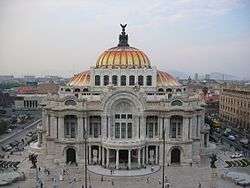Gran Teatro Nacional
The Great National Theatre of Mexico was a huge opera house in Mexico City..
Stages in its history

The theatre was built between 1840 and 1844 by architect Lorenzo de la Hidalga in Mexico City. It was located at the end of Cinco de Mayo Ave., on the street of Vergara (present-day Bolívar). It had a capacity of more than 3,500 people; that is to say, 1,500 more seats than the present-day Palacio de Bellas Artes.
Historians consider it the most important architectural work in Mexico City between the conclusion of the Metropolitan Cathedral and the building of the Palacio de Bellas Artes. The Great National Theatre was inaugurated during under one of Antonio López de Santa Anna's various periods as president. Its name changed successively, from Great Theatre of Santa Anna to Great Theatre Vergara, then Great Imperial Theatre, and finally Great National Theatre.
Great Theatre of Santa Anna

Great Theatre Vergara
Only during the opera season of 1852 the theatre premièred 17 operas and offered more than 60 performances.
Great Imperial Theatre
During the Second Mexican Empire, by command of emperor Maximilian I of Mexico, the theatre changed its name to Great Imperial Theatre. During this period it was directed by Spanish playwright José Zorrilla.

In this period a scandal occurred relating the première of the opera Ildegonda by Melesio Moralesl, which was finally premièred on 27 January 1866. Once the opera was ready, a group of notables, including Don José Urbano Fonseca and Don José Ignacio Durán, went to see the Great Imperial Theatre impresario, Don Annibale Biacchi, so that Morales's opera could be premièred there. Biacchi answered that he would not stage a work by a Mexican, which would damage his business. In this respect Manuel Mañón writes:[1]
Great National Theatre
After the death of the emperor Maximilian I of Mexico and the restoration of the Republic, the theatre was renamed Great National Theatre.
Around this time took place the worldwide première of Cleopatra by Melesio Morales, writes Mañón:[2]
Demolition

The Great National Theatre was demolished between 1900 and 1901 to prolong Cinco de Mayo Ave. The demolition was justified with the promise that it would be replaced by the Palacio de Bellas Artes, whose construction began in 1904, but was interrupted by the Mexican Revolution, finally opening in 1934. In the more than 30 years between the demolition of the old theatre and the inauguration of the Palacio de Bellas Artes, the opera performances took place at the Teatro Principal and the Teatro Arbeu. Of all these theatres the planes have been restored, and they could be rebuilt.
Worldwide premières at the Great National Theatre of Mexico
- 1859: Catalina de Guisa, three-act opera by Cenobio Paniagua.
- 1863: Romeo y Julieta, ópera de Melesio Morales.
- 1864: Agorante, rey de la Nubia, ópera de Miguel Meneses.
- 1866 (27 January): Ildegonda, three-act opera by Melesio Morales.
- 1871 (9 February): Don Quijote en la venta encantada, libretto by A. Garcìa and music by Miguel Planas.
- 1871 (13 September): Guatimozin, one-act opera by Aniceto Ortega de Villar, with tenor Enrico Tamberlick and soprano Ángela Peralta.
- 1877: Gino Corsini, four-act opera by Melesio Morales.
- 1891: Cleopatra, four-act opera by Melesio Morales.
References
- http://www.correodelmaestro.com/anteriores/2004/octubre/artistas101.htm
Bibliography
- Contenido magazine, March 2009, "Crónicas de la Ciudad: Así era el Gran Teatro Nacional", by Alberto Barranco Chavarría.
- Manuel Mañón: "Historia del viejo Gran Teatro Nacional de México, 1841-1901. Mexico, CONACULTA, 2010.
